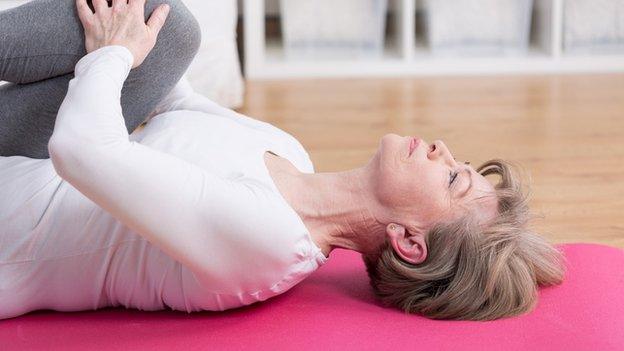Coronavirus: A lockdown journey from couch to kettlebells
- Published
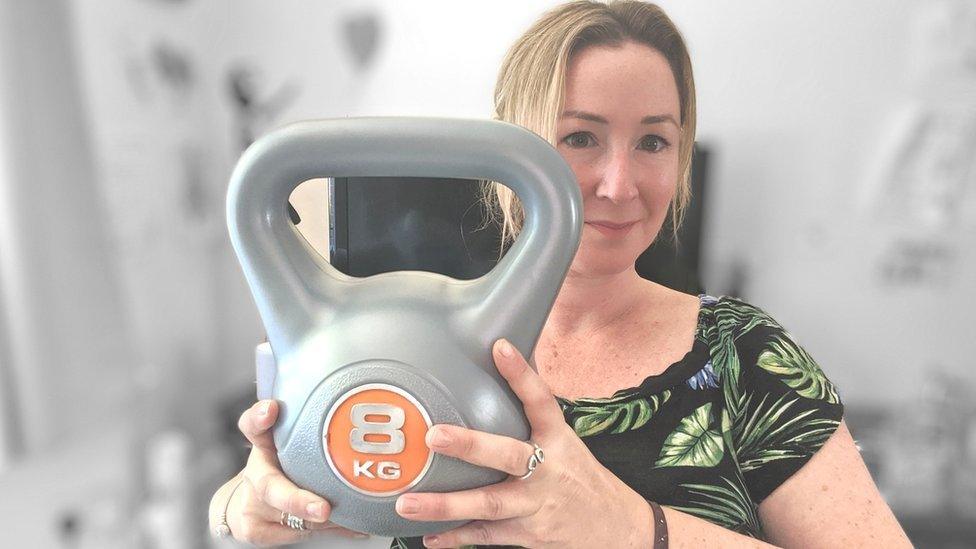
Of all the roles life has carved out for me, this one has to be one of the most unexpected.
But sharing my DIY lockdown kettlebell regime on social media, primarily for the purposes of self-motivation, has resulted in an avalanche of requests for help and support for others - mainly women - wanting to do the same.
My most recent picture, shared after eight weeks of almost (ahem) daily 20-minute workouts, had nearly 100,000 views and resulted in a very funny pitch from a fitness company wanting this 40-something BBC tech reporter to become a brand ambassador.
I'm not about to give up the day job, but it was a flattering - though undoubtedly misguided - gesture.
Allow X content?
This article contains content provided by X. We ask for your permission before anything is loaded, as they may be using cookies and other technologies. You may want to read X’s cookie policy, external and privacy policy, external before accepting. To view this content choose ‘accept and continue’.
Kettlebells are rounded weights that look a bit like a cannonball but with a handle. They date back to the 17th Century, but you may have found them a little harder to come by recently as demand in lockdown has soared.
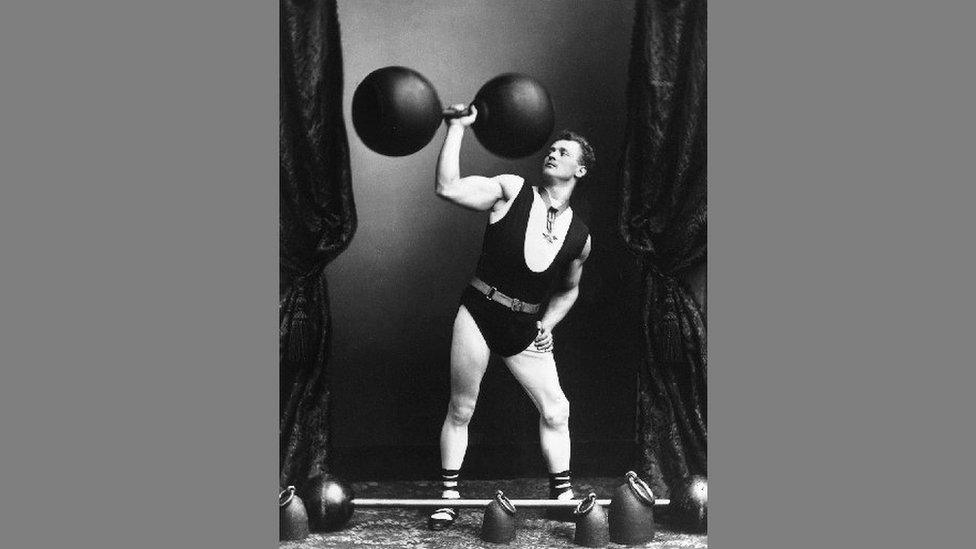
German strong-man Eugene Sandow (1867 - 1925) pictured with weights and an early form of kettlebell at his feet
Online searches for them in the UK practically doubled from 2.1 million in March to 4.1 million in May, according to Redbrain, an e-commerce platform with access to the data of millions of shopping searches and how they translate into sales.
At the beginning of March, I'd already had a set for several months - despite my best intentions I'd just never got round to using them.
When lockdown hit, I realised that I suddenly had an extra three hours in my working day that wasn't taken up by the commute - and that I was spending more time than ever sitting far too close to the snack cupboard at home.

However, also within reach were my dusty kettlebells, which had been deployed as doorstops.
I had absolutely no idea what to do with them.
Fortunately, there are plenty of people out there who do - Google "kettlebell workout" and you'll get around 34.5 million results.
I started clicking through them. Lots of them. Many did not hold my attention for very long. The workouts were too long, too fast, too painful - my 40-year-old joints wouldn't cope with that, how on Earth am I supposed to hold that there? And so on.
However, I also began to spot emerging themes in the exercises and I gained an understanding of which ones were best for achieving what I wanted: core strength.
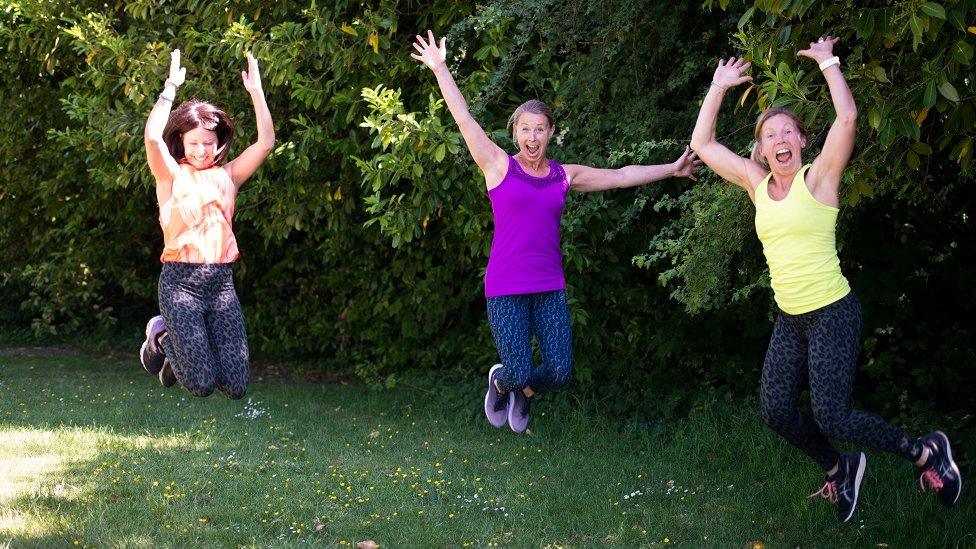
FitState founders Emma McCaffrey, Zoe Baker and Viki Potter have found a new audience online
Slowly, I built myself a workout based on those elements - adding some extra ones along the way as people started to contact me and share their own favourites (I'm not sure whether to be grateful for the recent addition of Russian twists, which are as painful as they sound).
While the online fitness industry has rocketed during lockdown, for some more traditional businesses it's meant a very dramatic change.
Personal trainers Emma McCaffrey, Zoe Baker and Viki Potter found themselves having to rethink their entire business model of outdoor classes for a core market of 35-50-year-old women practically overnight.
With Emma and Zoe based in Winchester and Viki in Wimbledon, their business, FitState, had been local to those two areas.
Since switching their classes to invitation-only Zooms, women from Wales, Bristol, Newcastle and the south of France have joined in.
"I don't think I'd really heard of Zoom, and suddenly we had 10 classes scheduled," said Zoe, recalling the start of lockdown.
After much trial and error, the trio have settled on a format that works. Clients don't have to use the camera if they would rather not, and everyone apart from the instructor is on mute throughout.
"We don't have music - it just doesn't work," says Emma. "It's clunky, tinny and people can't hear you."
It's also not the easiest way to teach and, of course, any feedback about technique or posture is impossible.
"When you're teaching online there's no banter, it's straight down to business. As the teacher, you are doing every exercise, keeping up the pace, keeping time, talking, breathing and keeping the tech going," says Emma.
However, the format has become so successful that they now plan to keep offering Zoom classes despite the loosening of lockdown rules.
"Zoom's not the same as face-to-face but it does feel like we're all together," says Emma. "It doesn't necessarily work better but we are finding that people are more likely to commit to it, and it's enabled people from all around the country to join us."
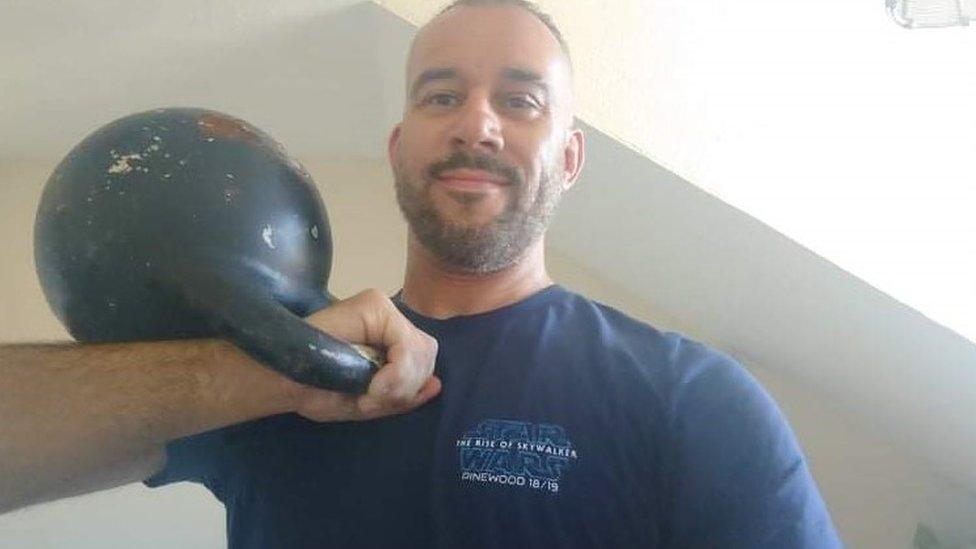
Kettlebell instructor Colin Howells
Colin Howells, a martial arts and advanced kettlebell instructor at Gym01 in Portsmouth, has decided to wait until the gym is able to reopen before he resumes coaching, face-to-face.
He does however have some advice for those of us picking up kettlebells for the first time.
According to him, the most common mistake beginners make is having the wrong posture.
Bending your back during the famous kettlebell swing move - where you swing the bell holding on to the handle with both hands from between your knees to shoulder height and back down again - can cause injury.
"You'll know if you're doing it wrong because one area of your body will feel sore and the rest won't," he says. "You're using eight muscle groups - there's no intense impact, you're letting gravity do the work. You shouldn't feel sore afterwards."
He also says it's important to choose the right weight and not to start out too light.
"On average, women start with a kettlebell weighing between 10 and 12kg (22-26lbs); 16kg (35lbs) for men," he says. "You'll never get the technique right if you don't have the correct weight.
"Make sure you keep your spine straight when you're swinging the kettlebell. Squat, with your feet about shoulder-width apart, put your weight on your heels, shoulders relaxed and back."
Although you gain a lot of momentum during the swing itself, try not to swing the bell above shoulder height, he adds.
"Always do a little pre-swing - gently, just between your legs, before you start, to minimise injury risk," Colin says.
He also advises changing the exercises around every few weeks.
"It's a really good exercise and really enjoyable," he says. "You could start to see results in a month if you stick to it."
When people first get into it, they realise they can shift the weight around easily and sometimes get a bit carried away," he adds.
"Keep it simple to start with."
As for me, well, I'm not planning a new career as a fitness guru. In fact, I'm looking forward to the day when a professional can actually watch me and tell me how I can continue to improve.
I think I'm on the right lines though because this week I managed to do a handstand for the first time in 30 years.
Yes, I was showing off in front of my children, but I would not have been able to do that in the days when I was on the early train to work, and those kettlebells propped open the door to the lounge.
- Published19 March 2020

- Published9 April 2020

- Attribution
- Published7 November 2018
